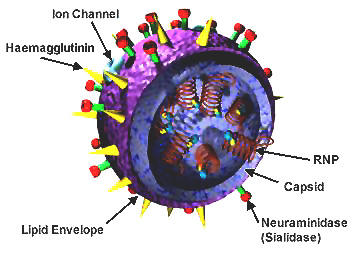Common Conditions
Influenza
Influenza, commonly known as flu, is an infectious disease of birds and mammals caused by RNA viruses of the family Orthomyxoviridae (the influenza viruses).
Symptoms
In humans, common symptoms of the disease are the chills, then fever, sore throat, muscle pains, severe headache, coughing, weakness and general discomfort. In more serious cases, influenza causes pneumonia, which can be fatal, particularly in young children and the elderly. Although it is sometimes confused with the common cold, influenza is a much more severe disease and is caused by a different type of virus.
Transmission
Typically influenza is transmitted from infected mammals through the air by coughs or sneezes, creating aerosols containing the virus, and from infected birds through their droppings. Influenza can also be transmitted by saliva, nasal secretions, faeces and blood. Infections also occur through contact with these body fluids or with contaminated surfaces.
Epidemics
Flu spreads around the world in seasonal epidemics, killing millions of people in pandemic years and hundreds of thousands in non-pandemic years. Three influenza pandemics occurred in the 20th century and killed tens of millions of people, with each of these pandemics being caused by the appearance of a new strain of the virus in humans.
The most famous and lethal outbreak was the so-called Spanish flu pandemic (type A influenza, H1N1 subtype), which lasted from 1918 to 1919. Current estimates say 50 million to 100 million people worldwide were killed. This huge death toll was caused by an extremely high infection rate of up to 50% and the extreme severity of the symptoms. The majority of deaths were from bacterial pneumonia, a secondary infection caused by influenza, but the virus also killed people directly, causing massive hemorrhages and oedema in the lung. The total mortality of the 1918–1919 pandemic is not known, but it is estimated that 2.5% to 5% of the world’s population was killed.
Later flu pandemics were not so devastating. They included the 1957 Asian Flu (type A, H2N2 strain) and the 1968 Hong Kong Flu (type A, H3N2 strain), but even these smaller outbreaks killed millions of people. In later pandemics antibiotics were available to control secondary infections and this may have helped reduce mortality compared to the Spanish Flu of 1918.
Often, these new strains result from the spread of an existing flu virus to humans from other animal species. A deadly avian strain named H5N1 has posed the greatest risk for a new influenza pandemic since it first killed humans in Asia in the 1990s. Fortunately, this virus has not mutated to a form that spreads easily between people.
Vaccinations
Vaccinations against influenza are usually given to people in developed countries with a high risk of contracting the disease and to farmed poultry. The most common human vaccine is the trivalent influenza vaccine that contains purified and inactivated material from three viral strains. Typically, this vaccine includes material from two influenza A virus subtypes and one influenza B virus strain. A vaccine formulated for one year may be ineffective in the following year, since the influenza virus changes rapidly over time, and different strains become dominant. More recently, human vaccine contains 4 viral strains.
Ministry of Health, Singapore, has advised vaccination against influenzae in high risk individuals, namely the elderly over the age of 70 years, anyone with underlying lung disease including asthma, anyone with underlying chronic medical problems such as diabetes mellitus, heart disease or stroke.
Treatment of Influenza
People with the flu are advised to get plenty of rest, drink a lot of liquids, avoid using alcohol and tobacco and, if necessary, take medications such as paracetamol to relieve the fever and muscle aches associated with the flu. Since influenza is caused by a virus, antibiotics have no effect on the infection; unless prescribed for secondary infections such as bacterial pneumonia.
There are two classes of anti-virals are neuraminidase inhibitors and M2 inhibitors (adamantane derivatives). Neuraminidase inhibitors are currently preferred for flu virus infections. The oral form is called Tamiflu and the inhaled form is called Relenza.
TEM of negatively stained influenza virons, magnified approximately 100,000 times
Structure of the influenza virion. The hemagglutinin (HA) and neuraminidase (NA) proteins are shown on the surface of the particle. The viral RNAs that make up the genome are shown as red coils inside the particle and bound to Ribonuclear Proteins (RNPs).


